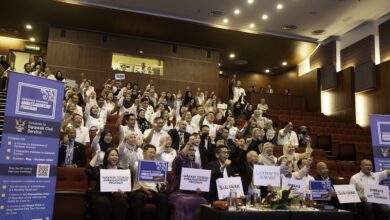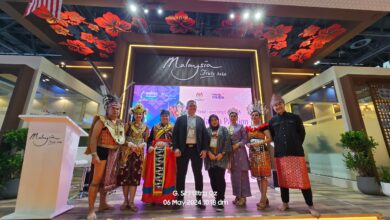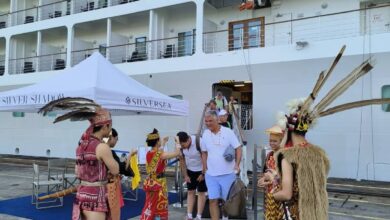The word Gawai’ originated from the Iban language that means ritual or festival, whilst Dayak refers to the native ethnic groups of Sarawak – the Iban, Bidayuh, Kayan, Kenyah, Kelabit, Murut, Lun Bawang – and many more. Gawai Dayak is celebrated to mark the end of the padi (rice) harvesting season and also a time of togetherness, a mark of gratitude for god and nature for the productive harvest, as well as prayer for a peaceful and prosperous future. Common events during the celebration are Kumang (Queen) and Keling (King) Gawai contests, Ngirup Ai Pengayu (Long Life Drink), traditional dancing and overall merrymaking.
Preparations for the Gawai festival start very early, with the brewing of tuak (traditional rice wine) and the making of traditional delicacies such as the kuih penganan (Mexican hat shaped cake), kuih sarang semut (fishnet-like crispy snack), kuih chuan (crispy flower snack), pulut lulun (glutinous rice steamed in bamboo), manuk daun ubi lulun (chicken and tapioca shoot steamed in bamboo), and many more. After the general cleaning of the longhouse, new mats will be laid out on the ruai (the open area which runs through the entire longhouse), with the walls are adorned with the pua kumbu (traditional handwoven fabric) display on the wall and placed on the table as table cloth.
Gawai celebrations at the longhouse offer celebrants a great time to wear traditional costumes. The women would wear the ngepan, a traditional costume for welcoming guests to the longhouse, wearing the sugu tinggi (Iban maiden headgear) as hair accessory. The men would wear cawat or sirat (loin cloth) with necklaces, armlets and anklets and a headgear made of peacock feathers.
The celebration typically starts on the evening of 31st May with the Muai Antu Rua (casting away the spirit of greed), signifying the chasing away of the spirit of bad luck. Traditionally each family at the longhouse would throw unwanted articles into a chapan (winnowing basket) that is dragged by two men as they pass each room along the longhouse. The unwanted articles will then be tossed to the ground from the end of the longhouse.
As the sun sets, a miring (offering ceremony) will take place, starting with the beating of the gendang rayah (ritual music). The Tuai Rumah (Longhouse Chief) thanks the gods for the good harvest, and asks for blessings, guidance and long life as he waves a cockerel over the offerings before ending the miring ceremony. Dinner is then served and just before midnight, a procession of young maidens and warriors in traditional garb go up and down the ruai seven times, and this is known as the Ngalu Petara (welcoming the spirit of the gods).
At midnight, the gong is sounded and the Tuai Rumah leads everyone in the longhouse in a toast with Ai Pengayu (a special kind of tuak) and wish each other “Gayu Guru, Gerai Nyamai” which translates to “Long Life, Health and Prosperity”.
The celebration turns merrier as some will dance to traditional music being played. Some will sing and recite their traditional poems (pantun or ramban), while some would perform the traditional dance form called Ngajat to symbolise the joy of a good harvest.
The male ngajat copies the mannerisms of a hornbill – considered the king of the birds – to show courage, heroism and strength. The ngajat of the ladies is the opposite, as it consists of soft, graceful movements with very precise body turns. A traditional band joins the dance troop giving life to the dance with their vibrant beats and tunes, playing the traditional folklore. There will also be blowpipe competitions as participants will take the opportunity to demonstrate their blowpiping skills.
On June 1st, the homes of the Dayaks are opened to visitors and guests, a custom known as Ngabang. Traditionally, when guests arrive at the longhouse, they are served with ai tiki as a symbol of welcoming them to their home. From time to time, guests are served with tuak and this would be called as “nyibur temuai” which literally means “watering the guests”.
For the Christian Dayaks, Gawai would also mean attending a church mass service to thank God for the good harvest. The Gawai celebrations usually lasts for several days, and it is also considered an auspicious time for wedding ceremonies and baptisms to take place.
COME AND EXPERIENCE GAWAI IN SARAWAK
In conjunction with 2023’s Gawai festival, everyone is invited to experience the festivity first-hand with the local community at the Sarawak Gawai Festival Open House, to be held at Rumah Matop longhouse in Betong, about 246km from Kuching, on 9th June 2023.
The open house aims to promote the rich cultural diversity of Sarawak and highlight the unique traditions and customs of the Gawai celebrations and visitors will have the chance to experience the warm hospitality and rich cultural heritage of the various ethnic groups in Sarawak. Not only will they get to taste traditional ethnic cuisines, visitors can also participate in cultural performances at the historic longhouse, which was built in 1941 from belian (ironwood) pillars.
Those interested in participating in the Gawai Dayak Open House can go to the website https://sarawak.travel/openhouse/ for more information.







